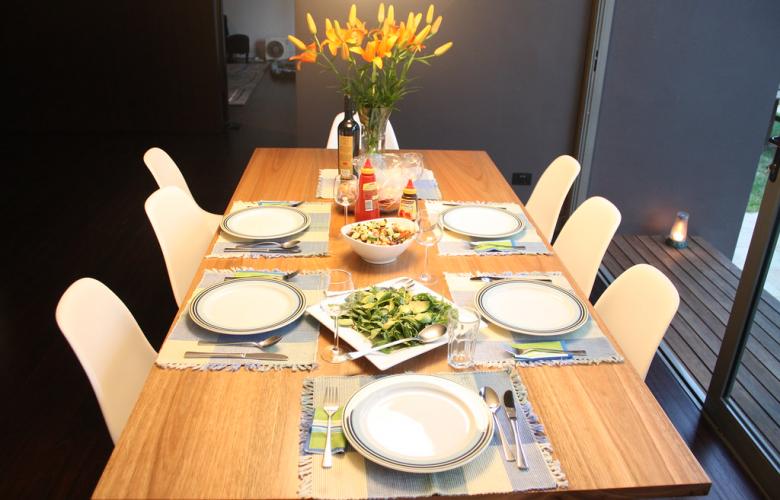Keep it simple
The first objection to hosting a dinner party in Japan is quite obvious to anyone who has ever set foot in an urban Japanese home: space is scarce. Most people live in apartments or condos that can't accommodate a large gathering the same way a Western home might. You'll most likey need to keep the number of guests to a minimum if you want everyone to be comfortable.
It's also advisable to keep the menu short and simple as Japanese kitchens also tend to be extremely small. Keep in mind that preparing multiple dishes at the same time can be difficult. Reason being that the number of burners on Japanese stove tops usually ranges between one and three (if you are lucky). There also isn’t much counter space to cut, prep or store menu items that don’t require cooking. A simple menu with fewer courses is your best bet for stress-free and mess-free hosting. Alternatively, consider buying some of the courses, for example the dessert, ready-made from one of the fancy food floors that you find in almost all Japanese department stores.
You don’t invite just anyone into your uchi
It is not only lack of space that prevents the Japanese from inviting friends over for a casual get-together over dinner — culture also plays a huge part in this phenomenon. Japanese culture differentiates between uchi and soto in almost all areas of life. Uchi is what is on the inside; soto is what is on the inside. This applies to homes, companies, circles of friends, and families alike. The uchi is known, safe, clean, intimate, and familiar, while the soto is the unknown, potentially dangerous and dirty, and out of the comfort zone. Home is uchi — a very private and sacred space. You would not invite just anyone in, only very close friends and family. There is an element of embarrassment and vulnerability in revealing such an intimate space to outsiders. Many even worry that their humble abode may not live up to visitors’ standards.
The Japanese art of omotenashi
This brings us to another element that prevents home parties from becoming a more frequent occurrence in Japan: omotenashi. The Japanese world for hospitality really takes tending to your guests to another level. Attending to and anticipating all of your guests' needs is a given in Japanese society and can easily be observed on a daily basis when interacting with service staff of any kind. They will almost always wear a uniform, be perfectly groomed, speak in a soft voice in the most polite form of Japanese and perform acts of service unseen in most Western countries — like seeing you off to the shop’s entrance before handing you your immaculately wrapped purchases and bowing at a 90-degree angle until you vanish from sight. If you decide to become a dinner host, the responsibility of exhibiting the same level of omotenashi will fall upon you, which can be considerable pressure.
Presentation is key
If you still aren’t put off by the idea of hosting a dinner party in Japan, this one simple tip might help turn it into a success: Presentation is key in Japanese culture. No matter how great your grandma’s borscht recipe tastes, it needs to be visually appealing at the same time. Putting careful thought into your table setting and decorations as well as food presentation will go a long way with your local guests. It will show that you are a subtle master of omotenashi who wants your guests to find joy in small details.
The Japanese make polite guests
In return for your hosting efforts, you will find that the Japanese make polite guests. It would be very rare for a Japanese visitor to arrive without a temiyage, a small gift for the host. They will usually present it while announcing “Tsumaranai mono desu” (“It is just something boring” — similar to the humble “It's only something small” in English). The gifts can range from a bottle of high-end alcohol, exotic fruits, chocolates, or maybe something from their home prefecture.
While guests can get loud, or even a bit rowdy, after a couple rounds of drinks, they usually know not to overstay their welcome, and generally start excusing themselves based on their last train times. Often guests will also offer to help with the dishes, but it is best to politely but strongly refuse in order to maintain your omotenashi hosting spirit.
Alternatives: Kashikiri and dinner plans
If hosting a party at your place sounds like too much effort for you, there are some good alternatives. Simply bandwagon on what most locals do when they have an occasion to celebrate: Rent out a restaurant or bar, either the whole venue or one of the private rooms. This is known as kashikiri in Japanese.
Or you can book a party plan at a restaurant or izakaya. Most places offer prix fixe menus. You simply choose menu items depending on your budget as usually several options are available. The hospitality industry in Japan caters very well to parties and celebrations given the constraints on home entertaining, and many places easily accept large group sizes. As that option saves you from revealing your private uchi and puts the responsibility of omotenashi on the restaurant, it is the usual route for most Tokyoites who have something to celebrate or want to bring their friends and family together.
By Mareike Dornhege
Similar to this:
Uchi-soto: How the Japanese concept that divides the "in" from the "out" reflects in Tokyo architecture
When East meets West: The contradictions and concessions of the modern Japanese home
Japanese furniture retailers: Embracing the aesthetic





